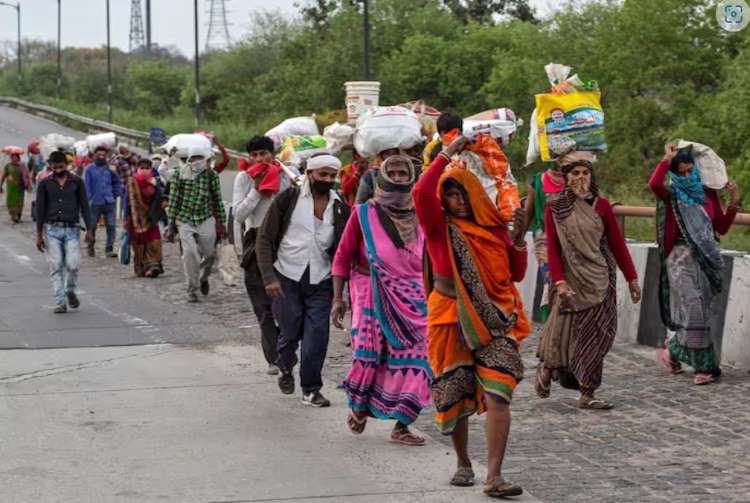
The Budget 2024, presented by finance minister Nirmala Sitharaman, has sought to tackle various economic and social challenges facing India. However, a significant omission is the lack of explicit provisions for inter-state and international migrant workers. According to the 2011 Census, India had 41.42 million inter-state migrant workers. The ministry of statistics and programme implementation reported that in 2020-21, the total migration rate in India was 28.9% — 26.5% in rural areas and 34.9% in urban centres.
In urban India, one in three residents is a migrant. Despite this, the concerns of migrant workers were not sufficiently addressed in the budget. On a positive note, several policies and programmes outlined in the budget indirectly impact migration and migrant labourers. However, the Budget failed to address the specific needs of migrant labourers.
READ I Chinese FDI: India must weigh risks and rewards
Employment and skilling initiatives
A critical aspect of the budget is the introduction of employment-linked incentive schemes designed to enhance formal employment and skilling, benefiting new entrants to the workforce and the manufacturing sector. Scheme A, titled first timers, offers a direct benefit transfer equivalent to one month’s wage, up to Rs 15,000, to first-time employees entering the formal workforce. This scheme potentially benefits 21 million youth, including many migrant workers who often seek formal employment opportunities upon relocating to urban areas. Scheme B, Job Creation in Manufacturing, incentivises additional employment in the manufacturing sector by providing financial support for EPFO contributions for both employees and employers over the first four years of employment.
Net migration in India (1000s)

These initiatives are particularly relevant for migrant workers, who frequently work in manufacturing units across urban centres. The aim is to increase formal employment, which is crucial for migrant workers who often work in informal and unprotected environments. By integrating migrant labourers into the formal sector, these schemes can improve their job security, social security benefits, and overall economic stability. However, while these schemes seek to integrate migrant workers into the formal sector, challenges such as inadequate outreach and awareness among migrant populations may hinder their effectiveness. Additionally, the one-time benefit under Scheme A may not be sufficient to ensure long-term job retention and stability for first-time employees.
Rental housing and urban housing initiatives
The government plans to facilitate rental housing with dormitory type accommodation in a public private partnership (PPP) mode, supported by viability gap funding, to provide affordable and accessible housing for industrial workers, many of whom are migrants. However, this approach raises concerns about the quality of living conditions in dormitory style accommodations which may not provide workers with the necessary privacy and personal space. The PPP model also risks prioritising profit over the well-being of migrant workers, potentially leading to substandard housing solutions if not adequately regulated.
In Kerala, the Apna Ghar residential scheme was introduced in 2019 to rent out secure and clean rooms to migrant workers from other states. Apna Ghar projects are suggested to be implemented in regions of Kerala where there is a lack of adequate lodging options for temporary workers. Beds are available to migrant workers for a monthly fee of ₹12.
Street markets and livelihood support
The budget includes provisions that support informal sector workers, indirectly benefiting migrant labourers. Building on the PM SVANidhi Scheme, the government envisions developing 100 weekly haats or street food hubs in select cities each year for the next five years. This initiative seeks to enhance the livelihoods of street vendors, many of whom are migrants.
Supporting street markets and informal sector workers is critical, as migrant labourers rely on these occupations for their livelihoods. By enhancing these markets, the government can provide more stable and profitable opportunities for these workers. However, it is essential to critically assess the implementation and sustainability of such initiatives to ensure the benefits reach the intended population and address the broader structural issues faced by informal sector workers and migrant labourers.
While enhancing street markets to benefit migrant workers is commendable, it is crucial to address significant barriers that interstate and intrastate migrants face in accessing these benefits. Many migrants work without proper documentation, often a prerequisite for accessing government schemes like PM SVANidhi. This lack of documentation prevents a substantial portion of the intended beneficiaries from availing themselves of the scheme’s provisions, undermining its inclusivity and effectiveness.
Moreover, the sustainability of these initiatives needs improvement. While developing weekly haats can provide immediate livelihood opportunities, a long-term strategy is required to ensure these markets thrive and continue to support migrant workers. This includes providing infrastructure, ensuring legal protections for vendors, and integrating these markets into the broader urban economy.
Labour reforms and integration of services
The budget outlines several labour-related reforms to enhance employment and skilling services, including integrating the e-Shram portal with other platforms to create a comprehensive one-stop solution for labour services. This initiative aims to facilitate job matching, skilling, and employment opportunities, particularly benefiting migrant workers who frequently encounter obstacles in accessing these services.
While these reforms have the potential to significantly improve the support system for migrant workers by providing essential resources and opportunities for livelihood enhancement, it is crucial to critically assess the implementation and effectiveness of such integrations. Challenges such as digital literacy, bureaucratic inefficiencies, and the actual reach of these services to the most vulnerable populations must be addressed to ensure the proposed benefits are fully realised.
Agricultural productivity and resilience
While the budget’s primary focus remains on urban-centric policies, it also includes measures to enhance agricultural productivity and resilience, which could indirectly influence migration patterns. Notably, the release of 109 high-yielding and climate-resilient varieties of 32 field and horticulture crops bolsters agricultural sustainability. Additionally, the development of large-scale clusters for vegetable production near major consumption centres and the promotion of Farmer-Producer Organisations, cooperatives, and startups aim to streamline vegetable production and supply chains.
By improving agricultural resilience, these initiatives have the potential to mitigate the push factors driving rural-to-urban migration, offering more stable and profitable farming opportunities, and potentially slowing the rate of migration by addressing the root causes of rural displacement. However, the emphasis on urban-centric policies in the budget suggests a potential imbalance in resource allocation, which may undermine the long-term effectiveness of these agricultural measures in curbing migration.
Migration in the Union budget
Despite the indirect benefits provided by the budget, it is crucial to explicitly address the challenges faced by migrant workers within national fiscal policies. Migrant labourers are a significant part of the Indian workforce, contributing to various sectors such as construction, manufacturing, and services. However, they remain one of the most vulnerable and marginalised groups due to their informal work status, lack of social security, and poor living conditions.
Explicitly including migration and migrant labourers in the Union Budget would ensure targeted interventions that address their specific needs. For instance, detailed data collection on migrant populations could improve policy formulation and implementation. Dedicated programs for migrant workers’ health, education, and social security could enhance their quality of life and economic contributions, as well as promote interstate collaboration on migrant issues.
Recent climate-induced disasters, such as the landslides in Wayanad, Kerala, highlight the urgent need for comprehensive policies that address the vulnerabilities of migrant workers. These workers often face discrimination and neglect during disaster response and rehabilitation phases due to the lack of adequate data and formal recognition. Ensuring their inclusion in national policies would provide them with the necessary protection and support during such crises.
While the Union Budget 2024 has several measures that indirectly benefit migrant workers, it falls short of addressing some unique challenges they face. Integrating migration and migrant labourers into national fiscal policies is essential for creating an inclusive and equitable economic environment. By doing so, India can ensure the well-being and empowerment of this critical segment of its workforce, ultimately contributing to the nation’s overall economic growth and social stability.
(The authors are associated with ANRF Project, Mahatma Gandhi University, Kottayam.)
